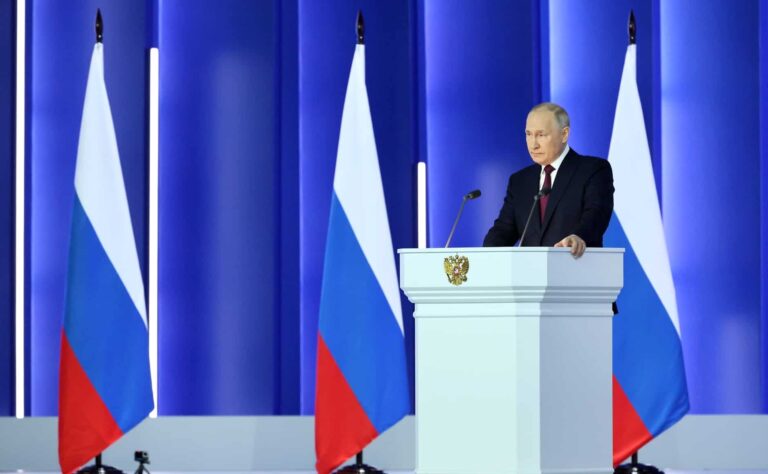From 2011 to the present to curb Russia’s nuclear advance was the New Start treaty. Here is what it is and what it provides. It may have limited immediate effects, but it marks the final end of the phase of atomic arms control and limitation.
At the end of his address to the nation on Tuesday, Russian President Vladimir Putin announced the suspension of Russia’s participation in the New START (Strategic Arms Reduction Treaty).
It has been in force between the United States and Russia since 2011, was last renewed in 2021, expires in 2026 and is the last existing nuclear arms control treaty.
Table of Contents
New Start nuclear treaty, what it implies
Russia’s suspension of participation means an end to the exchange of information regarding their respective arsenals between the two world’s largest nuclear powers. And, for the first time since 1972 puts an end to all sorts of mutual inspections.
In fact, the treaty was already suspended because since 2019 these inspections had not been possible. First because of problems with the coronavirus pandemic, then because of rising tensions and the Russian invasion of Ukraine.
The formal suspension of New START, however, may mark the final end of the season of nuclear arms control and limitation, after some treaties had already been phased out or allowed to expire over the past decade.
The New START treaty provided for a reduction in so-called “strategic” nuclear warheads. Which, unlike “tactical” nuclear warheads, used on the battlefield, are deployed far from the front line. And to damage the enemy’s ability to wage war. Thus also having a deterrent function.
The 2010 agreements were signed by then-Presidents Barack Obama and Dmitri Medvedev. And, were renewed in 2021. This is just days after the start of Joe Biden’s presidency (Donald Trump’s previous administration had shown little interest in a renewal).
Putin suspends the Treaty, the possible consequences
Vladimir Putin in Tuesday’s speech justified the suspension of participation in the treaty by talking about what he called “the West’s aggression” against Russia. According to the Russian president’s propaganda, it was not possible to allow U.S. inspectors to visit Russian nuclear sites. This is because they could have passed sensitive information to the Ukrainian government.
He also accused the U.S. of banning inspections by its own inspectors. Which the U.S. government calls false, claiming that they expected only reciprocity of visits.
Putin then clarified that the suspension does not imply a final withdrawal from the treaty. And that they will not resume nuclear tests unless the “United States resumes them first.” Later, the Russian Foreign Ministry assured that Russia does not intend to deploy more nuclear warheads than the treaty limits.
The immediate effects of the suspension may be limited. As mentioned, inspections had already been blocked for some years. And the United States still seems to be able to monitor remotely, especially with the use of satellites, the movements of Russia’s nuclear arsenal. However, the suspension of routine communications between the two countries regarding nuclear weapons will not be totally without consequences.
Moreover, the decision seems to permanently enshrine the end of the nuclear control and nonproliferation period. Which was already in crisis after some previous decisions. The last one had been the U.S. government’s announcement of formal withdrawal from the Intermediate-Range Nuclear Forces Treaty (INF). Thus, the agreement that in 1987 banned any ground-based ballistic and cruise missiles with ranges between 500 and 5,500 kilometers. Then the U.S. withdrew from the treaty, accusing Russia of violating it.
Are new future treaties about nuclear possible?
New START, due to expire in 2026, would not be further renewable. But it needs replacement with a new treaty. Current relations between Russia and the United States however, make this prospect highly unlikely.
In addition, today, unlike in the past, there are no longer only two powers with significant nuclear arsenals. And, among those with the most, is the country that most threatens U.S. supremacy in the world, namely China.
For this reason, the United States had expressed its intention to involve the Chinese government in talks on future agreements regarding nuclear arms control. But, it received a “no” response for now. The Chinese government, according to intelligence sources, is pursuing a long-term plan to catch up with Russia and the United States at 1,550 nuclear warheads.
North Korea’s missile tests and Iran’s nuclear program must also be placed in this international context. The decades-plus trend that seemed to be established regarding a limitation of nuclear weapons as a tool of power and deterrence seems to have been reversed at this stage.
Read also: The world divided over Ukraine, resolution condemning invasion to be voted at UN General Assembly












